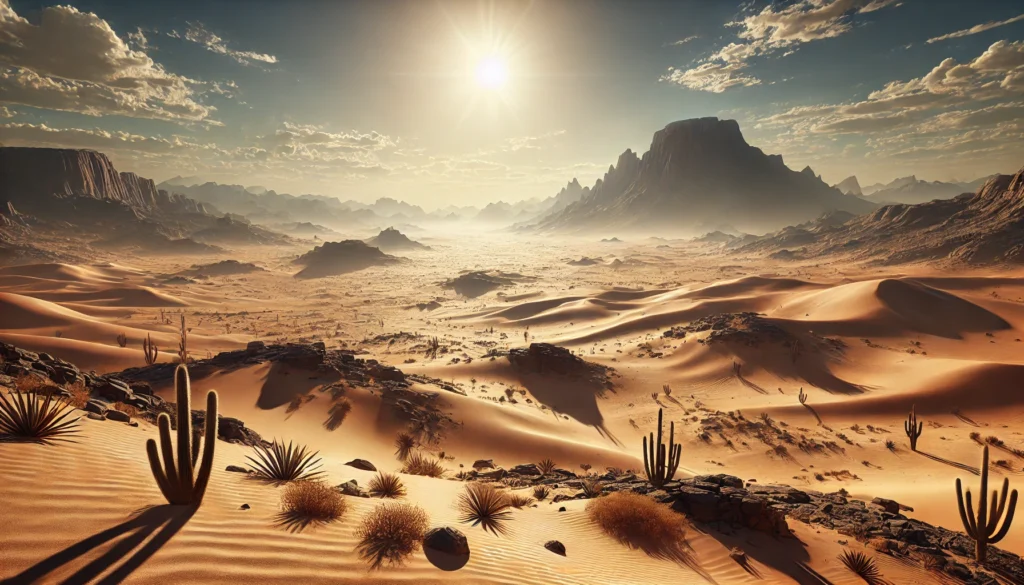What is a dry desert ?
A dry desert is an arid expanse where rainfall is scarce, and the relentless solar dominates the landscape. These parched areas, often characterized by using great stretches of sand, rocky plateaus, or barren plains, undergo high temperature fluctuations—scorching warmness through day and biting cold via night. Vegetation, if present, is sparse and adapted to preserve water, even as wildlife includes resilient species which have evolved resourceful survival mechanisms. The environment is often without humidity, and winds, unhindered by moisture, sculpt dunes and erode stone formations over millennia. In these inhospitable terrains, existence persists towards bold odds, embodying nature’s unyielding tenacity.

Why are deserts dry?
Deserts remain due to a convergence of atmospheric and geographical effects that prevent rain. These regions are within constant high pressure areas and feel that they cover wind streams that suppress the shooting and effectively prevent rain. Some deserts appear in the shade of impressing mountain ranges, where moisture filled with moisture loses the moisture to the air and crosses the extension of Lewards. Others, especially the coastal dryer, take the form of streams of the temptation sea that reduce atmospheric temperature, and reduce the air capacity to maintain moisture and cause rain.
This chronic dryness is further improved by acute solar radiation, which accelerates evaporation and stripes the country with regardless of moisture present. With rare vegetation for anchor moisture, these rugged landscapes withstand scorched days and terrible nights, creating an environment where it is only the most flexible flora and creatures – which can be equipped with extraordinary existence systems – remain – remaining the complex differences in this climate and geological and geological Forces cement the desert in the form of the most drought and the most unforgivable ecosystem on the earth.
List of Largest Deserts in the World by Area
| 1 | Antarctic Desert | Polar Ice & Tundra | Largest desert, permanently ice-covered | 14,200,000 | 5,482,651 | Antarctica | N/A |
| 2 | Arctic Desert | Polar Ice & Tundra | Frozen expanse covering the Arctic region | 13,900,000 | 5,366,820 | North America, Europe, Asia | United States (Alaska), Canada, Greenland, Russia, Norway, Sweden, Finland, Iceland |
| 3 | Sahara Desert | Subtropical | Largest hot desert, extreme temperature shifts | 9,200,000 | 3,552,140 | Africa | Algeria, Chad, Egypt, Libya, Mali, Mauritania, Morocco, Niger, Sudan, Tunisia, Western Sahara, Eritrea |
| 4 | Arabian Desert | Subtropical | Vast arid expanse with shifting dunes | 2,330,000 | 899,618 | Middle East | Saudi Arabia, UAE, Iraq, Jordan, Kuwait, Oman, Qatar, Yemen, Egypt, Israel, Palestine |
| 5 | Great Australian Desert | Subtropical | Harsh, arid interior of Australia | 1,371,000 | 529,346 | Australasia | Australia |
| 6 | Gobi Desert | Cold Winter | Rocky, barren landscape | 1,295,000 | 500,002 | Eastern Asia | China, Mongolia |
| 7 | Kalahari Desert | Subtropical | Semi-arid savanna with diverse wildlife | 900,000 | 347,492 | Southern Africa | Botswana, Namibia, South Africa |
| 8 | Patagonian Desert | Cold Winter | Largest desert in South America | 673,000 | 259,847 | South America | Argentina, Chile |
| 9 | Syrian Desert | Subtropical | Rocky plateau with scarce vegetation | 500,000 | 193,051 | Western Asia | Syria, Jordan, Iraq, Saudi Arabia, Turkey |
| 10 | Great Basin Desert | Cold Winter | Largest U.S. desert, semi-arid | 492,098 | 190,000 | North America | United States |
| 11 | Chihuahuan Desert | Subtropical | Unique desert ecosystem, high elevation | 453,248 | 175,000 | North America | Mexico, United States |
| 12 | Karakum Desert | Cold Winter | Wind-sculpted dunes, extreme temperatures | 350,000 | 135,136 | Central Asia | Turkmenistan |
| 13 | Great Victoria Desert | Subtropical | Largest desert in Australia | 348,750 | 134,653 | Australasia | Australia |
| 14 | Taklamakan Desert | Cold Winter | One of the most extreme sand deserts | 337,000 | 130,191 | Eastern Asia | China |
| 15 | Colorado Plateau | Cold Winter | Known for deep canyons and mesas | 336,700 | 130,116 | North America | United States |
| 16 | Sonoran Desert | Subtropical | Rich biodiversity, home to saguaro cacti | 310,000 | 119,692 | North America | Mexico, United States |
| 17 | Kyzylkum Desert | Cold Winter | Dry, sandy desert with scattered vegetation | 300,000 | 115,831 | Central Asia | Kazakhstan, Turkmenistan, Uzbekistan |
| 18 | Ogaden Desert | Subtropical | Arid plains, known for extreme droughts | 256,000 | 98,842 | Eastern Africa | Ethiopia, Somalia, Somaliland |
| 19 | Thar Desert | Subtropical | India’s great desert, semi-arid climate | 238,254 | 77,220 | South Asia | India, Pakistan |
| 20 | Puntland Desert | Subtropical | Arid plateau, part of the Somali Peninsula | 200,000 | 77,220 | Eastern Africa | Somalia |
| 21 | Ustyurt Plateau | Temperate | Semi-desert landscape with rocky outcrops | 200,000 | 77,220 | Central Asia | Kazakhstan, Turkmenistan, Uzbekistan |
| 22 | Guban Desert | Subtropical | Lowland desert along the Gulf of Aden | 175,000 | 67,568 | Eastern Africa | Somalia, Somaliland |
| 23 | Namib Desert | Cool Coastal | One of the world’s oldest deserts | 160,000 | 61,776 | Middle & Southern Africa | Angola, Namibia, South Africa |
| 24 | Margo Desert | Subtropical | Barren, arid plains with sand dunes | 150,000 | 57,915 | Southern Asia | Afghanistan |
| 25 | Registan Desert | Subtropical | Sand dunes of the Afghan desert | 146,000 | 56,371 | Southern Asia | Afghanistan |
| 26 | Atacama Desert | Mild Coastal | Driest non-polar desert on Earth | 140,000 | 54,054 | South America | Chile, Peru |
| 27 | Danakil Desert | Subtropical | Home to volcanic activity, salt flats | 137,000 | 52,896 | Eastern Africa | Djibouti, Eritrea, Ethiopia |
| 28 | Mojave Desert | Subtropical | Includes Death Valley, the driest U.S. area | 124,000 | 47,877 | North America | United States |
| 29 | Chalbi Desert | Subtropical | Salt flats, occasional seasonal lakes | 100,000 | 38,610 | Eastern Africa | Kenya |
| 30 | Columbia Basin | Cold Winter | Expansive basalt plateau | 83,139 | 32,100 | North America | Canada, United States |
| 31 | Kavir Desert | Subtropical | Saline marshes and dry basins | 77,000 | 29,730 | Southern Asia | Iran |
| 32 | Ferlo Desert | Subtropical | Semi-arid savanna with sand dunes | 70,000 | 27,027 | Western Africa | Senegal |
| 33 | Ladakh Desert | Cold Winter | High-altitude desert in the Himalayas | 59,146 | 22,836 | Southern Asia | India |
The Driest Desert in the World
The Atakama Desert: Earth’s Dry Forest Nord -chile has an extension of stretching, Atakama Desert Stark, other beauty in 1000 km. Surrounded by Peru, Bolivia and Argentina, it sits within one of the most inaccessible areas of the planet.Like the most dry -polar desert on earth, Atakama gets less rainfall than the free -rich country of Antarctica. Some weather stations scattered in their dry expansion have never recorded a single drop of rain. This extreme dracing leaves a lot from a desert without plant or wildlife, especially in the lower height. However, along the northern coastal edges, the occasional moisture flows inland, which covers the severity of the curse and allows for the pocket of the hardy vegetation.
Why is the atakama desert so dry?
Three convergence forces make Atakama the most dry place on earth.First, the desert lies in the shade of the Andes rain. Business winds filled with south-east are forced to climb huge peaks. As the wind increases, it cools, condensed in the rain that nourishes the eastern slopes – leaves atakama in always drought on the west side.
Second, continuously dominates the high pressure system area. This declining air mass gets hot because they sink, evaporating any moisture mark before it can be condensed in rainfall.
Finally, the Frigid Humbolt stream, which performs the track north of the Pacific coast, plays an important role. This cool ocean stream suppresses the formation of rain -bearing clouds, ensuring that any wind from the sea matures. Together, these factors create a landscape where rain almost none.
